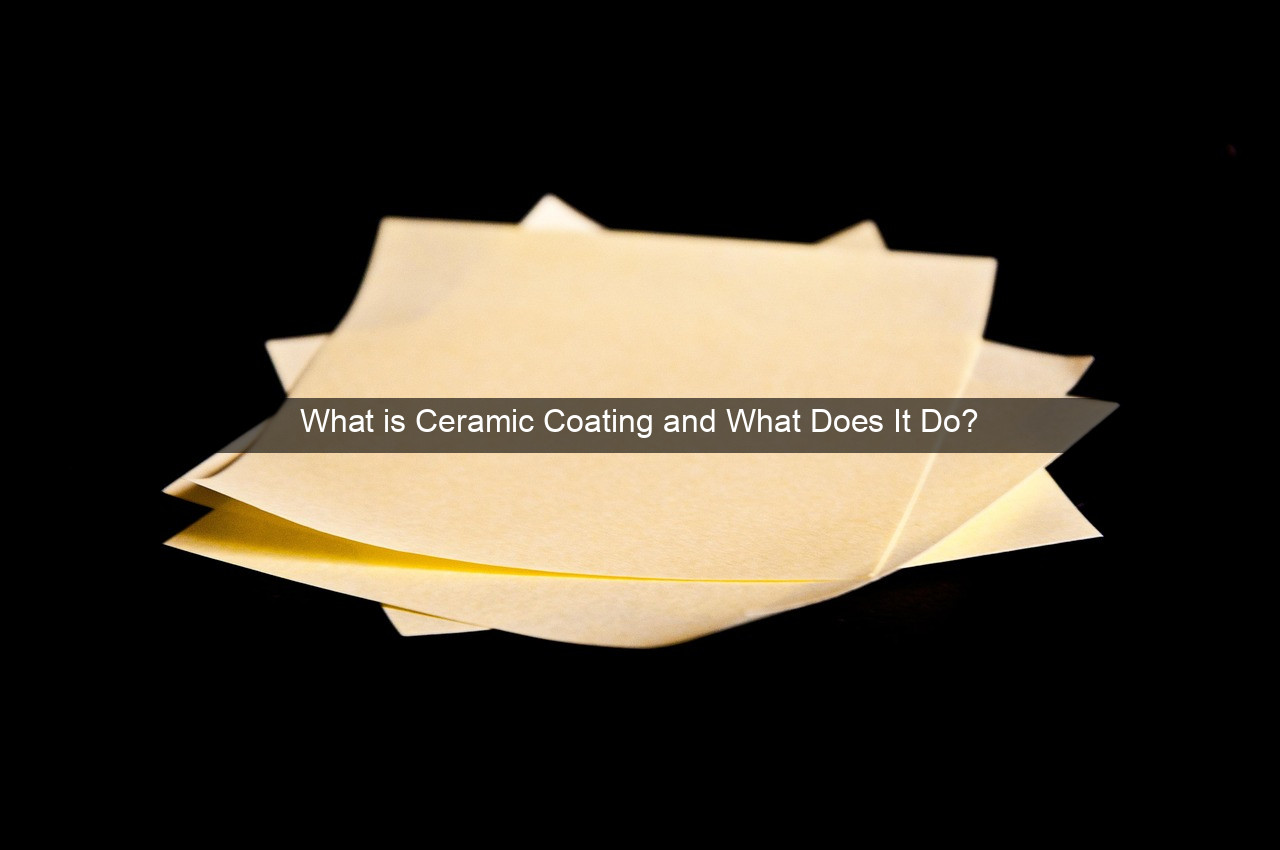What is Ceramic Coating and What Does It Do?

- What is Ceramic Coating and What Does It Do?
- What is Ceramic Coating and What Does It Do?
- The Science Behind Ceramic Coatings
- Understanding Nanotechnology
- The Composition of Ceramic Coatings
- Benefits of Ceramic Coating
- Protection and Durability
- Enhanced Aesthetics and Ease of Maintenance
- Types of Ceramic Coatings
- Consumer-Grade vs. Professional-Grade
- SiO2-Based Coatings vs. Other Formulations
- Conclusion

What is Ceramic Coating and What Does It Do?

Imagine a shield, invisible yet incredibly powerful, protecting your car’s paint from the relentless onslaught of the elements. That’s the essence of a ceramic coating. This advanced technology, born from nanotechnology, has revolutionized car care, offering unparalleled protection and a showroom shine that lasts for years. Forget waxing every few months; ceramic coatings provide a semi-permanent bond with your car’s paint, creating a durable, hydrophobic layer that repels water, dirt, and other contaminants. This not only keeps your car cleaner for longer but also minimizes the risk of scratches, swirl marks, and other imperfections that can dull your paint’s finish. In this comprehensive guide, we’ll delve deep into the world of ceramic coatings, exploring their composition, benefits, application process, and much more, empowering you to make an informed decision about protecting your prized possession.
The Science Behind Ceramic Coatings
Understanding Nanotechnology
Ceramic coatings leverage the power of nanotechnology, manipulating materials at the atomic level to create incredibly thin yet remarkably strong protective layers. These coatings are composed of silicon dioxide (SiO2), the primary component of glass, which forms a tight bond with the car’s clear coat. This bond creates a super-hydrophobic surface, meaning water beads up and rolls off, taking dirt and grime with it. This “self-cleaning” effect significantly reduces the need for frequent washing and minimizes the risk of scratching during the cleaning process.
The nanoscale particles in ceramic coatings fill in microscopic imperfections in the clear coat, creating a smooth and even surface. This enhances the paint’s gloss and depth, giving it a richer, more vibrant appearance. Furthermore, the chemical resistance of SiO2 protects the paint from environmental contaminants like acid rain, bird droppings, and tree sap, which can etch and damage the clear coat over time.
The application of a ceramic coating is a meticulous process that requires specialized knowledge and equipment. Proper surface preparation is crucial, involving thorough cleaning, decontamination, and often paint correction to remove any existing imperfections. The coating is then carefully applied in thin, even layers, ensuring complete coverage and a uniform finish. Once cured, the ceramic coating forms a durable, long-lasting bond with the paint, providing years of protection and enhanced aesthetics.
The Composition of Ceramic Coatings
The primary ingredient in ceramic coatings is silicon dioxide (SiO2), commonly found in quartz and sand. This compound is incredibly hard and durable, providing exceptional scratch resistance and protection against environmental contaminants. Different manufacturers may add other elements to their formulas, such as titanium dioxide (TiO2), which enhances UV protection, and various polymers that contribute to the coating’s hydrophobic properties and overall durability.
These additives are carefully formulated to create a synergistic effect, maximizing the coating’s protective qualities and enhancing its aesthetic benefits. The specific composition of a ceramic coating will vary depending on the brand and intended use, with some formulations designed for specific paint types or environmental conditions. Understanding the composition of a ceramic coating can help you choose the right product for your car’s needs and achieve the desired level of protection and shine.
The chemical structure of SiO2 allows it to form a strong, covalent bond with the car’s clear coat, creating a semi-permanent layer of protection. This bond is significantly stronger than that of traditional waxes or sealants, which explains the extended durability of ceramic coatings. This strong bond also contributes to the coating’s resistance to chemicals, UV rays, and other environmental factors that can degrade the paint’s finish over time.
Benefits of Ceramic Coating
Protection and Durability
Ceramic coating offers superior protection against various environmental hazards. It acts as a sacrificial barrier against UV rays, preventing oxidation and fading of the paint. The hydrophobic nature of the coating repels water, dirt, and grime, making it easier to clean and maintain the vehicle’s appearance. This protection extends to chemical contaminants like bird droppings and tree sap, which can etch and damage unprotected paint.
The durability of ceramic coating is a key advantage. Unlike waxes and sealants that require frequent reapplication, a ceramic coating can last for several years, providing long-term protection and shine. This durability translates to less time and money spent on car maintenance, allowing you to enjoy a pristine-looking vehicle with minimal effort.
Beyond its protective qualities, ceramic coating enhances the overall aesthetic appeal of the car. It adds depth and gloss to the paint, making it appear richer and more vibrant. The smooth, hydrophobic surface also minimizes the appearance of swirl marks and other minor imperfections, giving the car a showroom-worthy finish that lasts.
Enhanced Aesthetics and Ease of Maintenance
One of the most noticeable benefits of ceramic coating is the enhanced aesthetics it provides. The coating adds a noticeable depth and gloss to the paint, making it appear richer and more vibrant. This enhanced shine is not just a temporary effect; it lasts for years, thanks to the coating’s durability.
Ceramic coating significantly simplifies car maintenance. The hydrophobic surface repels dirt and grime, making it much easier to wash the car. Often, a simple rinse with water is all that’s needed to remove light dirt and dust. This reduces the need for frequent washing and minimizes the risk of introducing swirl marks and scratches during the cleaning process.
The smooth surface created by the ceramic coating also makes it more resistant to swirl marks and other minor imperfections. This is particularly beneficial for darker colored cars, which tend to show swirl marks more readily. With a ceramic coating, your car’s paint will maintain its flawless finish for much longer.
Types of Ceramic Coatings
Consumer-Grade vs. Professional-Grade
Ceramic coatings are available in various formulations, catering to different needs and budgets. Consumer-grade coatings are typically easier to apply and offer a good level of protection for DIY enthusiasts. However, they may not be as durable or offer the same level of gloss as professional-grade coatings.
Professional-grade ceramic coatings are formulated for experienced detailers and offer superior performance and longevity. These coatings often require specialized application techniques and curing equipment, but the results are typically more impressive, providing a higher level of gloss, hydrophobic properties, and durability.
Choosing the right type of ceramic coating depends on your budget, experience level, and desired results. If you’re looking for a DIY solution, a consumer-grade coating can be a good option. However, for the ultimate protection and shine, professional application of a high-quality ceramic coating is recommended.
SiO2-Based Coatings vs. Other Formulations
Most ceramic coatings are based on silicon dioxide (SiO2), the primary component of glass. SiO2 provides exceptional hardness, durability, and chemical resistance, making it an ideal base for protective coatings. However, some manufacturers incorporate other materials into their formulations to enhance specific properties.
Some ceramic coatings may include titanium dioxide (TiO2) to improve UV protection, or polymers to enhance hydrophobic properties and flexibility. These additions can tailor the coating’s performance to specific needs and environmental conditions.
Understanding the different formulations can help you choose a ceramic coating that best suits your requirements. While SiO2-based coatings are generally preferred for their durability and protective qualities, other formulations may offer specific advantages depending on your priorities.
| Feature | Consumer-Grade | Professional-Grade |
|---|---|---|
| Durability | 1-2 Years | 2-5+ Years |
| Hardness | Lower | Higher |
| Gloss | Good | Excellent |
| Application | Easier | More Complex |
| Cost | Lower | Higher |
- Improved gloss and shine
- Protection against UV rays
- Hydrophobic properties
- Resistance to scratches and swirl marks
- Easier cleaning and maintenance
Conclusion
Ceramic coatings offer a significant advancement in car care, providing a level of protection and shine that surpasses traditional waxes and sealants. While the initial investment may be higher, the long-term benefits in terms of reduced maintenance, enhanced aesthetics, and preserved resale value make ceramic coatings a worthwhile consideration for any car owner. By understanding the science, benefits, and different types of ceramic coatings available, you can make an informed decision about protecting your vehicle and keeping it looking its best for years to come.
How long does a ceramic coating last?
The lifespan



